
Corvette XP-700
Designed and built in 1960 under the personal supervision of Bill Mitchell, the wild-looking XP-700 used many regular Corvette components, such as the frame, chassis parts and engine. The fiberglass body was extensively redesigned with a “grand prix” appearance. The long, low front overhang, large air scoops, exposed frontal areas and wire wheels with racing hubs were a few of the “grand prix” touches. The bubble-shaped laminated plastic canopy – coated with vaporized aluminum to help block the sun’s rays – was one of the most memorable features of the car. A metal strut in the center of the canopy featured louvered vents which enhanced circulation in the passenger compartment. Among the more exotic concepts: An overhead mirror, mounted above the windshield with a viewing porthole in the roof structure. The rear end styling influenced the second generation Corvettes.
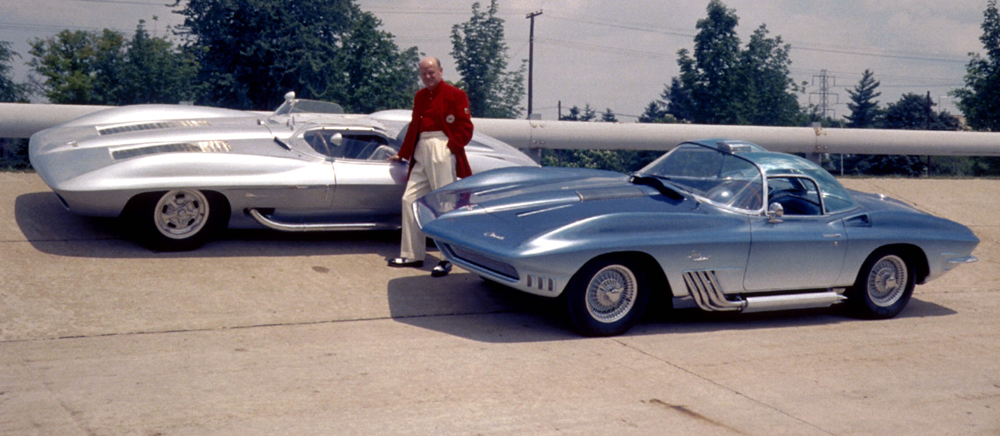
Corvette Shark
Later known as the “Mako Shark I,” the Corvette Shark of 1961 was the brainchild of Bill Mitchell. Legend surrounds the origin of the car, including Mitchell’s flash of inspiration after catching a shark while deep-sea fishing. The Shark looked like a real shark, with a mouth, gills and a shark-like paint scheme that gradated from blue/gray on the top to silver/white on the bottom (along the rocker panels). Memorable features include a sharp, menacing “nose” and four-into-two side pipes. The Shark, along with the Stingray Racer, heavily influenced the body design of the second generation of Corvettes.
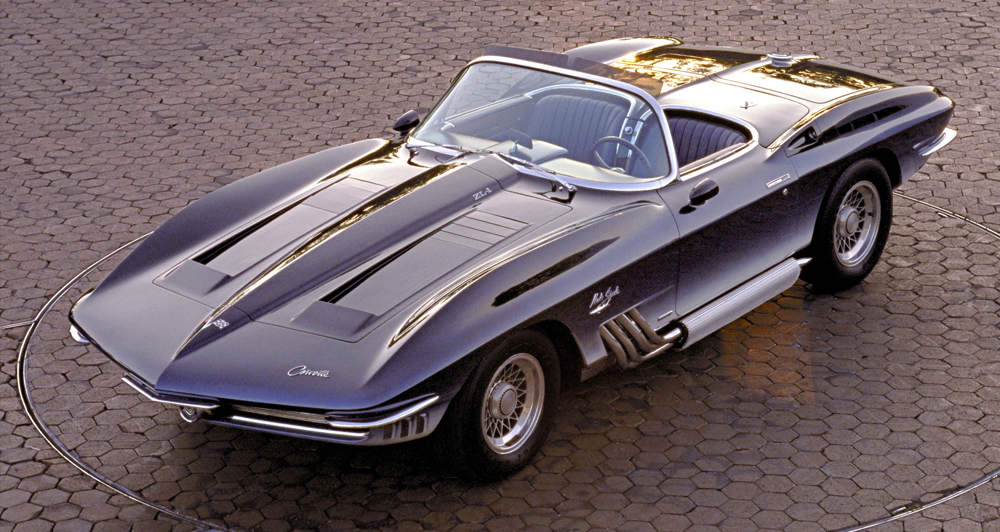
1961 Mako Shark Corvette
The 1961 Chevrolet Corvette Mako Shark (XP-755 Shark) show car was designed by Larry Shinoda under the direction of GM Design head Bill Mitchell as a concept, for future Chevrolet Corvettes. A mako shark captured off the coast of Florida by Mitchell inspired the basic lines of the show car.
The Mako Shark – along with the Sting Ray racing car designed by Mitchell and Shinoda two years earlier – influenced the sleek styling of the 1963 Corvette, including the production car’s signature blistered fenders. As a concept, however, the Mako Shark’s design was more dramatic and differed from the production Corvette with six taillights instead of four, a longer and more pointed nose that more closely emulated the look of a shark and the addition of a clear glass roof with a periscope-like rearview mirror.
The Mako was finished in a blended paint scheme based on an iridescent blue upper surface that transitioned into a white side and lower body, resembling the natural coloring of the shark Mitchell landed.
A number of experimental engines have been tested in the Mako, including a super-charged engine with four side-draft carburetors, a fuel-injected engine and a V-8 with two four-barrel carburetors. The present engine is a production 1969 427-cubic-inch ZL-1 “big block.” This engine has an all aluminum block, heads and intake manifold. It is equipped with a single four-barrel carburetor that produces about 425 horsepower.
The Mako Shark was built on a slightly modified production Corvette chassis and was fitted with cast magnesium wheels.
In May 1954, Bill Mitchell was named director of styling. He was serving in that position when he was selected to head the Styling Staff after Harley Earl ‘s retirement in 1958. As vice president of Styling, Mitchell forged an identity of his own. Whereas Earl liked his cars rounded with lots of chrome, Mitchell preferred razor-sharp edges. Among the Mitchell design team standouts are the 1963 Buick Riviera, the 1963 Chevrolet Corvette Sting Ray, Mitchell liked to build dream cars. Many were highly modified production cars or vehicles that linked appearance and performance. The 1961 XP-755 Shark, later renamed Mako Shark I, the 1965 Mako Shark II, the 1969 Corvette Aero Coupe are prime examples of this.
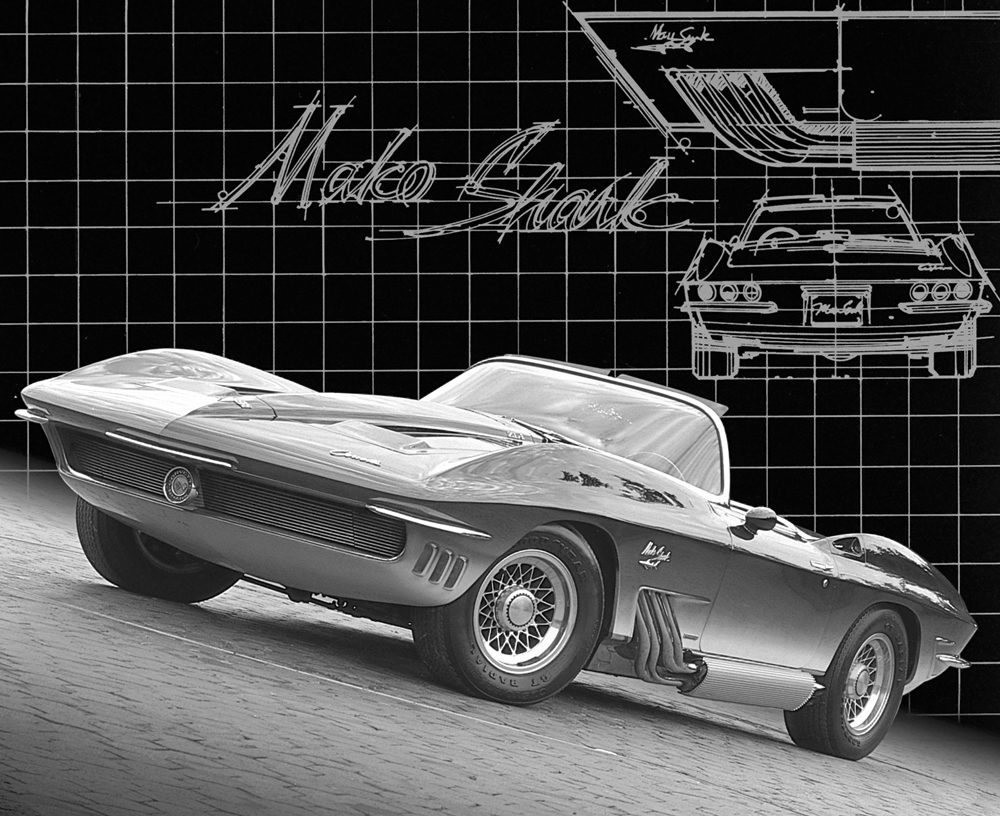

Corvette Mako Shark II
This concept car’s claim to fame was its influence on the redesigned Corvette of 1968. The Mako Shark II debuted in 1965 as a show car. Chevrolet actually created two of them – only one of which was fully functional. The non-running show car sported some interesting, futuristic details, such as square section side pipes and a squared-off steering wheel. While the functioning version didn’t have these features, it did have a retractable rear spoiler, and a square section bumper that could be extended for added protection. The Mako Shark II was powered by a 427 Mark IV engine which became available on production Corvettes. The paint scheme continued the Shark I tradition, with blue/gray on top and silver/white on the bottom (along the rocker panels).

Astro I
The Astro I appeared in 1967 as a radical-looking fastback coupe designed for the show circuit. The car’s height was under three feet, and hinged rear body/door section allowed access to the cockpit. A periscope rearview mirror on the roof provided a wide-angle view. Twin aircraft-style controls were used in place of a steering wheel.

Astro II (XP-880)
The Astro II, revealed at the 1968 New York Auto Show, was less extreme in its styling than Astro I. Astro II was designed primarily to showcase its rear-mounted powertrain application. Unlike the Astro I, Astro II had doors to access the passenger compartment. The rear compartment hatch still lifted up – this time, to provide access to the engine compartment. The front compartment was designed as a storage area.
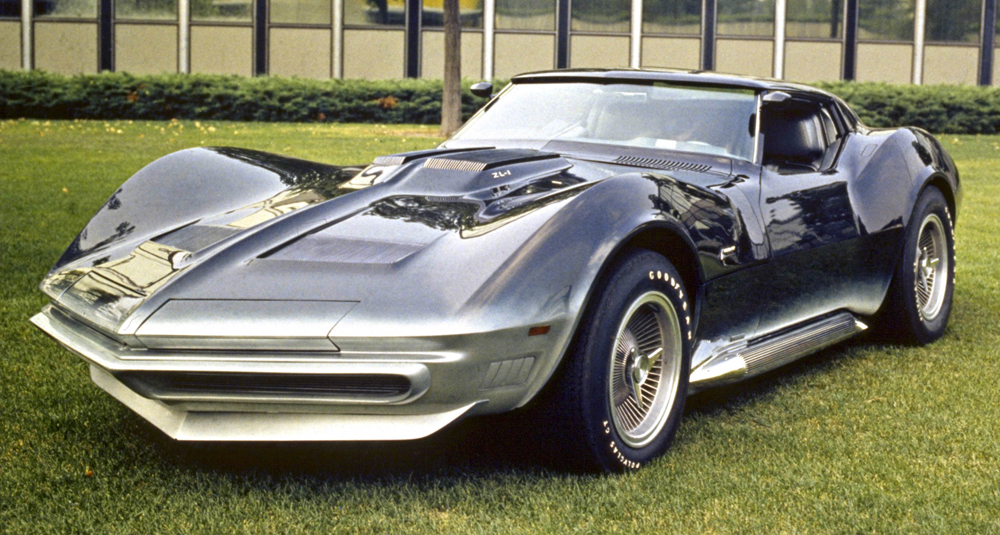
1965 Manta Ray Corvette
The Mako Shark II was built in 1965 under the direction of Bill Mitchell, and set the design standard for the 1968-1982 production Corvette. It made its debut at the 1965 Paris Auto Show. This hand-built Corvette was a favorite of Mitchell’s and he drove it daily. Its paint scheme matched the original Mako Shark, which was constructed four years earlier. The original Mako Shark was then retroactively called the “Mako Shark I”.
The Mako Shark II contained many notable features for 1965. It had a one-piece front-end that hinged forward for access to the engine bay, a removable hardtop, knock-off aluminum wheels and a big block 427 that was later replaced with an all aluminum ZL-1 engine. With a touch of a button a retractable rear bumper could extend outwards to protect the bodywork while parked; a very inventive feature for the time. Also at the rear, was a large wing, which was adjustable from the driver’s seat to ensure high-speed stability.
The interior contained controls for remote control operation of the automatic transmission, a digital read-out for the speedometer and fuel gage, and stereo speakers in the head rests for the driver and passenger. There were 17 different electric motors controlling different functions.
Having served its purpose, the Mako II should have been retired, but at GM even show cars can be face lifted, so in 1969 the Mako II was returned to the GM design studios and was transformed into the Manta Ray
A front spoiler was added, the grille got a little more protection, and the external exhaust pipes were redesigned to be a bit rounder and more conventional than before. The body side emblems changed from a stylized shark to a stylized manta ray, Goodyear tires replaced the Firestones, the former venetian blinds rear window treatment changed to a buttress style, and the shape of the rear end was longer and more horizontal. The hood scoop carried ZL-1 engine badging.
When the Manta Ray was retired it went to Bill Mitchell’s garage, where it joined the Mako I. Eventually they both became part of the GM Heritage Center Collection.
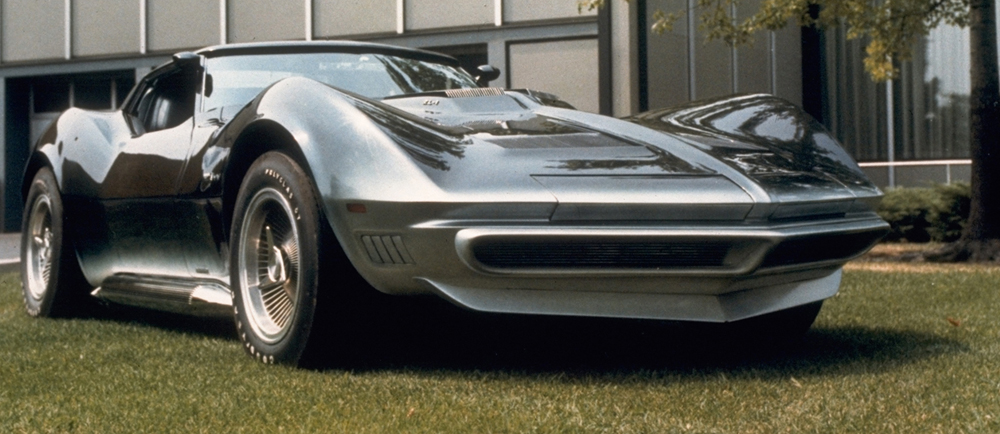
1969 Manta Ray Corvette
The Manta Ray was a redesigned Mako Shark II sent on the 1970 show circuit. The Manta Ray featured many of the Mako II’s outward features, such as side exhaust and a lower-body (along the rocker panels) silver paint job. The most notable change was the inclusion of the Chevy aluminum-block 427 cubic-inch ZL1 V8 engine which produced 430 horsepower.

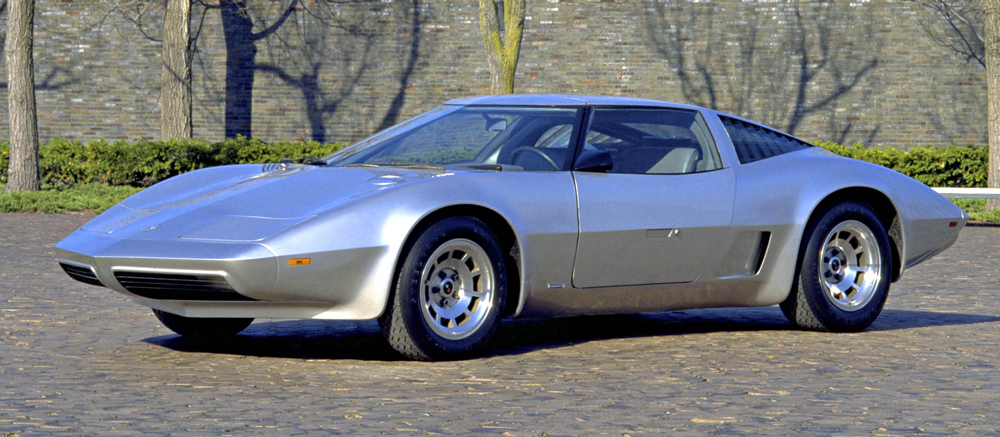
1973 Chevrolet Aerovette
Astro-Vette was an experimental Corvette built in 1978. The primary technological goal of Astro-Vette was to improve aerodynamics and minimize drag coefficient. The car featured a low, slanted windshield and long, sloping hood shaped much like the fourth generation Corvette. The flowing rear deck was reminiscent of the ’60s Stingray Racer. Louvered intakes on either side opened automatically via air pressure. One of Astro-Vette’s most distinctive features was a combination roll-bar/air foil on the rear deck, directly behind passenger compartment. Astro-Vette also featured wheel skirts over the rear wheel openings – hinged to allow access to the rear wheels – and flush aluminum wheel covers.
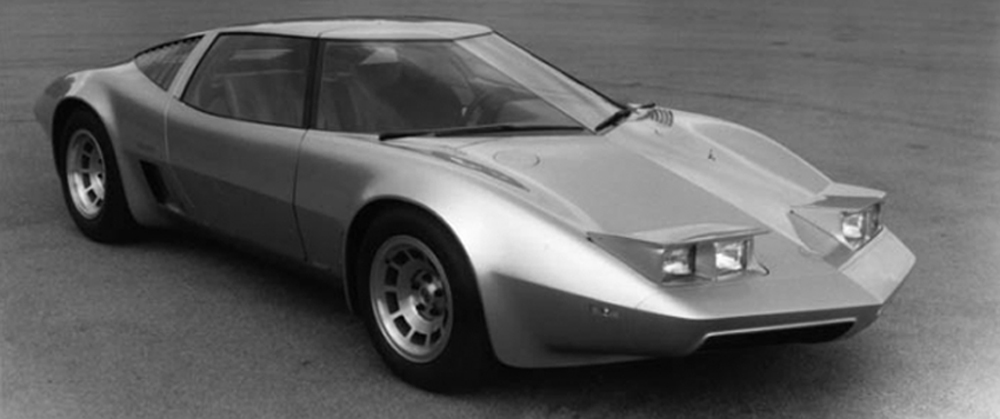
Corvette 4-Rotor
Built in 1972, the 4-Rotor experimental car debuted at the Paris Auto Salon in 1973. The 4-Rotor was one of many ‘Vette-inspired specialty cars that pushed the envelope of radical changes – changes that were never adopted for production partly because of cost/feasibility issues, and partly because they just didn’t fit within Corvette’s established character. These ideas included gull-wing doors, and a mid-ship mounted Wankel™ rotary engine. The 4-Rotor featured high-tech interior displays and readouts and aerodynamic styling that influenced future Corvette designs

Corvette Indy
Built in 1985, Indy was first shown at the Detroit Auto Show in 1986. Dubbed a research vehicle, the Corvette Indy showcased Chevrolet’s advanced technology. The “centerpiece” of the car was a mid-ship mounted twin-turbo intercooled 2.65-liter 32 valve DOHC Lotus-designed V8 Indy engine. The engine was nicknamed for its cousin, the Chevy Indy V8 racing engine. Horsepower has never been published, but is estimated at approximately 600. Four-wheel drive, four-wheel steering and an active suspension were a few of the advanced technologies showcased on the car. A CRT screen mounted on the dash provided rearward vision via a remote camera. Indy incorporated many “advanced” technologies that are now standard on the 1997 Corvette, including ABS braking, electronic traction control and electronic throttle control.

1990 Chevy Corvette CERV III Concept
(CERV I, II, AND IV) CERV stands for Chevrolet Engineering Research Vehicle. These vehicles are experimental cars used to test new technologies. The “CERV” designation dates back to the early days of the Corvette. Zora Arkus-Duntov designed a singleseat, open-wheel racer dubbed CERV I. He also designed CERV II – the world’s first mid-engine car with full-time four-wheel drive. In appearance, they looked nothing like the Corvette. They were used to demonstrate the performance and engineering capabilities of GM to the public. The next CERV to be created, CERV III, was a mid-engine, fully functional Corvette show car which debuted at the Detroit International Auto Show in 1990. During the development process of the fifth-generation 1997 Corvette, a fourth CERV was created. Of the four, CERV IV was the only one designed with a front-mounted engine.

You must be logged in to post a comment.